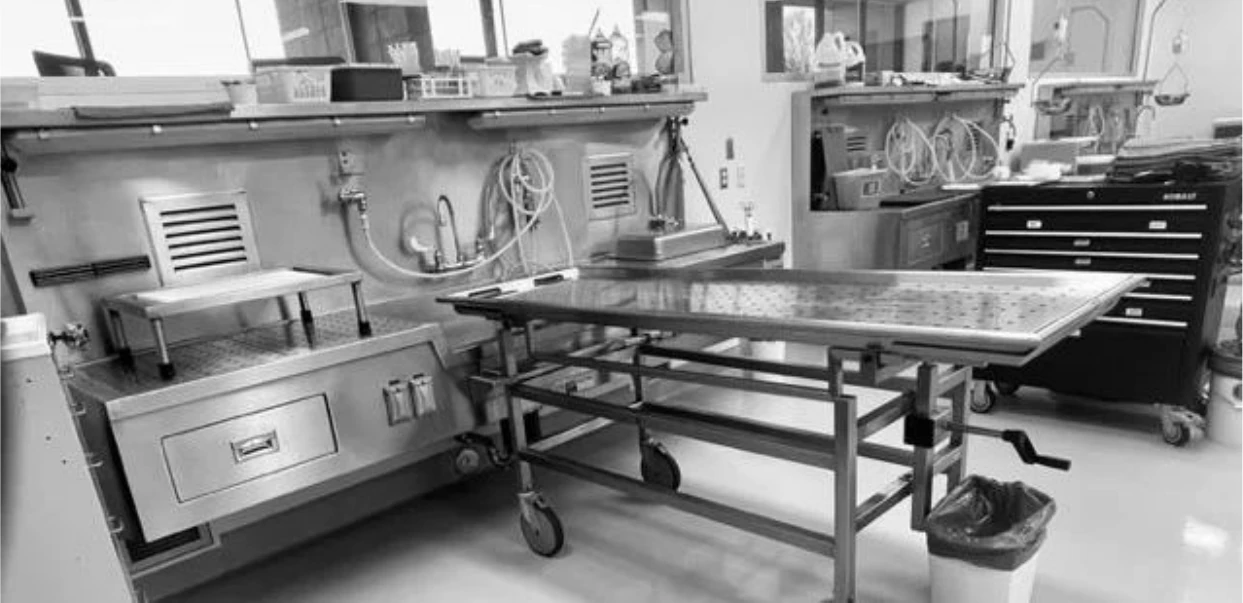The Pinal County Medical Examiner’s Office released its comprehensive 2024 Annual Report, providing critical data that law enforcement agencies, public health officials, policymakers, hospitals, the county attorney’s office, and the public use to understand caseload trends and enhance public safety in one of Arizona’s fastest-growing counties.
Purpose and Scope of Operations
The Pinal County Medical Examiner’s Office (PCMEO) investigates sudden, violent, unexpected, and suspicious deaths within the geographical boundaries of Pinal County, Gila County, and portions of Yuma County under intergovernmental agreements. The office determines cause and manner of death as required by law, distributing complete findings to families and law enforcement agencies.
Chief Medical Examiner Dr. John X. Hu and Medical Examiner Dr. Andrea W. Oeinck lead the office, which operates 24 hours a day, seven days a week from its facility at 920 North Bowling Road in Florence. Gila County, with approximately 50,000 residents, contracts with the PCMEO since it lacks its own medical examiner’s office. The office received 245 Gila County death referrals in 2024, assuming jurisdiction in 120 cases. Yuma County submitted 24 complex cases under an agreement effective since summer 2021 for forensic examination.
Growing Caseload Reflects Population Boom
Pinal County’s explosive population growth directly correlates with increased death investigations. The county’s population reached 484,239 residents in 2023, with 2024 showing continued rapid expansion at 3.6% – outpacing Arizona’s statewide growth rate of 2%. This makes Pinal County one of the fastest-growing counties in Arizona.
The PCMEO received 1,124 Pinal County death referrals in 2024, assuming jurisdiction in 624 cases (55.5%). Overall casework increased by 13% in Pinal County alone, with a 10% increase when including Gila and Yuma County cases. This represents a significant workload for the office’s seven full-time medicolegal death investigators and two forensic pathologists.
The office also processed 2,306 cremation permit authorizations for Pinal County and maintained an average examination report completion time of 34.6 days.
Comprehensive Investigation Process
Compiling the annual report requires intensive analysis of numerous factors for each case. Investigators examine not only cause and manner of death but also demographics including age, sex, and gender. They analyze circumstances surrounding lifestyle factors such as health history, alcohol or drug use, and history of mental illness, creating a comprehensive picture that informs public health and safety initiatives.
Natural Deaths Most Common
Natural deaths accounted for 214 cases (34.2%) of jurisdictional deaths in 2024, making them the most common manner of death. Heart disease emerged as the leading natural cause, consistent with national trends where cardiovascular conditions top mortality statistics.

Various forms of heart disease caused the majority of natural deaths, reflecting broader public health challenges facing Arizona communities.
Accidental Deaths Close Second
Accidental deaths comprised 271 cases (33.6%) in 2024, ranking as the second-most common manner of death. Drug and/or alcohol intoxication was a factor in 90 accidental deaths, representing a significant portion of these fatalities. Motor vehicle collisions ranked as the second-highest category of accidental deaths.

Motor Vehicle Fatalities Surge
Motor vehicle collision deaths increased dramatically to 84 cases in 2024, representing a 23.5% jump from 68 deaths in 2023. This alarming trend affects multiple victim categories, with passenger vehicle drivers accounting for 41.4% of motor vehicle collision fatalities.
The annual report reveals concerning restraint compliance issues: 65% of passenger vehicle drivers in fatal crashes were unrestrained. Among all occupants in passenger vehicle or all-terrain vehicle crashes, 32 of 49 were unrestrained. Investigators find these statistics particularly disappointing since these deaths could potentially be prevented.
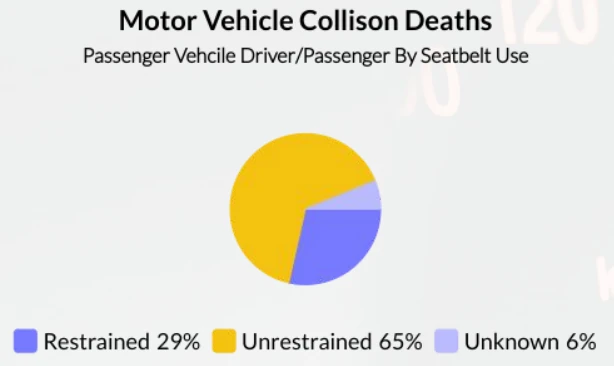
Toxicology results revealed concerning substance use patterns among drivers. Of 35 passenger vehicle driver fatalities tested, 45% returned positive results for one or more substances. The most common substance detected overall was alcohol above the legal limit. However, for motorcycle deaths specifically, THC emerged as the most common substance detected.
Drug Deaths Reveal Historic Shift in Patterns
Among the deaths where the PCMEO assumed jurisdiction in Pinal County, 105 cases in 2024 were determined to have resulted from acute drug toxicity or had drug use as a contributing factor to death. This represents a 5% increase from 2023.
A significant shift occurred in 2024: methamphetamine became the most commonly detected drug in toxicology among drug-related deaths, surpassing fentanyl for the first time in recent years. Methamphetamine was detected in 58% of drug-related deaths and fentanyl in 38%.
The office has tracked 784 drug-related deaths since 2017, with fentanyl involvement (either alone or combined with other substances) accounting for 40.5% of cases.
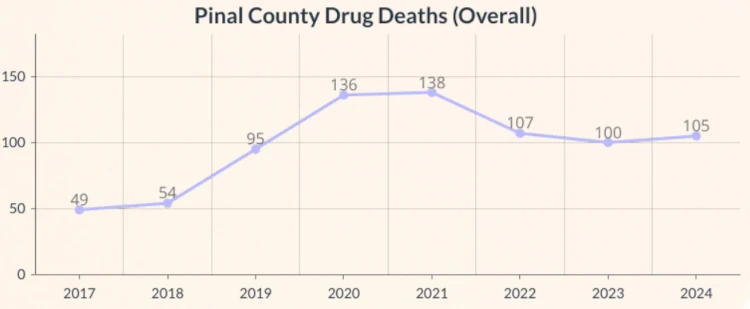
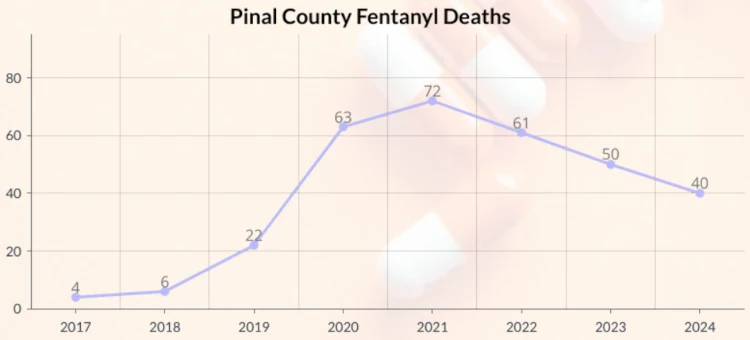
White non-Hispanic males with a mean age of 46.5 years remained most likely to die from acute drug toxicity. However, Hispanic males with a mean age of 32.9 years showed the highest risk for fentanyl-specific deaths.
Suicide Deaths Continue Upward Trend
Suicide deaths reached 98 cases in 2024, representing an 8.8% increase from 2023. Firearms caused 66.3% of these deaths, with White non-Hispanic males aged 51–60 comprising the highest number of cases. White non-Hispanic males accounted for 74.5% of all suicide deaths.
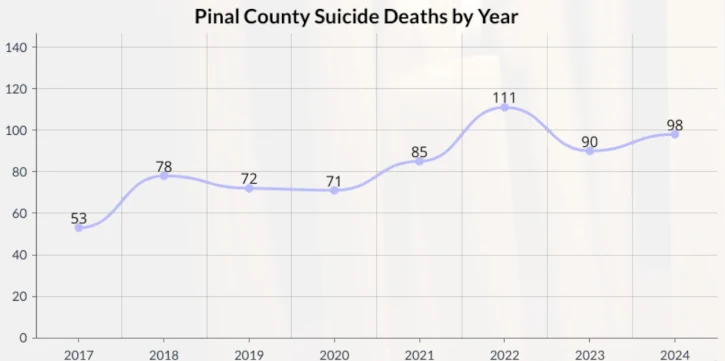
Males accounted for 88.7% of suicide deaths, consistent with national patterns where men represent nearly 80% of suicide fatalities despite comprising 50% of the population.
Homicide Deaths
The office investigated 23 homicide cases in 2024, representing deaths caused by the action of one person directly and purposefully causing the death of another. According to national data, there were 24,849 homicide deaths in the United States in 2022, representing a 4.5% decrease from 2021. Arizona recorded 629 homicide deaths statewide in 2022, with a rate of 9.0 deaths per 100,000 population.
The vast majority of homicides nationally result from firearm-related incidents. Capital punishment remains a legal penalty in Arizona, with lethal injection as the primary method of execution since 1992, though no judicial executions occurred in the state during 2024.
Officer-Involved Shootings
Five officer-involved shootings occurred in 2024, representing an increase from three in 2023. Three of these shootings involved Gila River Police Department officers, while one each involved Pinal County Sheriff’s Office and Coolidge Police Department personnel.
Veteran Deaths Reflect Service Population
All 69 Veterans whose deaths were investigated in 2024 were male, with 66.7% aged 51 or older. Accidental deaths accounted for 33.3%, and natural deaths 31.8%. All Veteran suicide deaths involved male individuals.
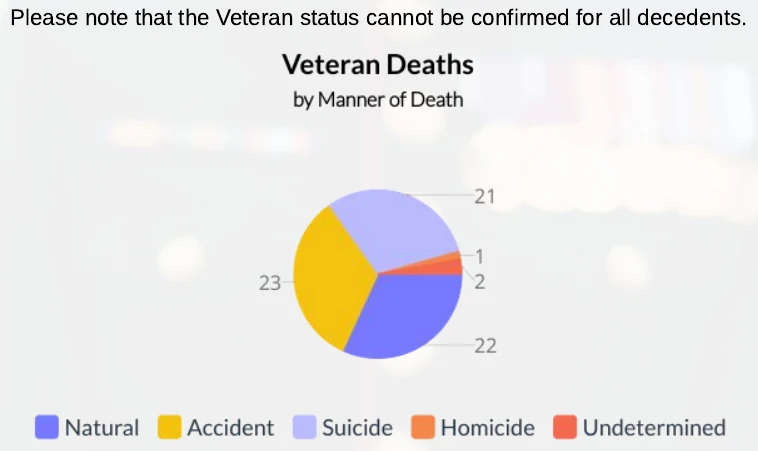
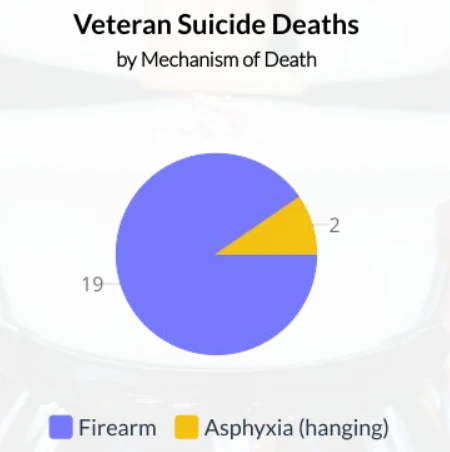
In-Custody Deaths Show Institutional Challenges
The office investigated 38 in-custody deaths in 2024, a slight increase from 37 in 2023. Twelve of the 38 in-custody deaths (31.5%) occurred in Arizona Department of Corrections facilities. Natural deaths comprised 42.1% of in-custody deaths, making them the most common manner of death in this category.

All in-custody deaths in 2024 involved male individuals. The PCMEO performed full autopsies on 83% of all in-custody cases.
Child and Infant Deaths Highlight Safety Concerns
The office investigated seven infant deaths (birth to one year) in 2024, with 42% attributed to unsafe sleep conditions including co-sleeping, bed sharing, or placement on adult beds with excessive bedding or pillows that could block airways.
Additionally, 16 child deaths (ages one to 14) occurred, with 62% resulting from preventable accidents, including four firearm-related fatalities. The remainder involved drownings and other events.
Homeless Deaths
The Pinal County Medical Examiner’s Office determined cause and manner of death for 30 individuals confirmed as homeless or chronically unhoused at the time of death in 2024. The annual report highlights the heightened vulnerability of this population, citing external research that shows sudden cardiac death occurs at a rate seven times higher among individuals experiencing homelessness compared to the general population.
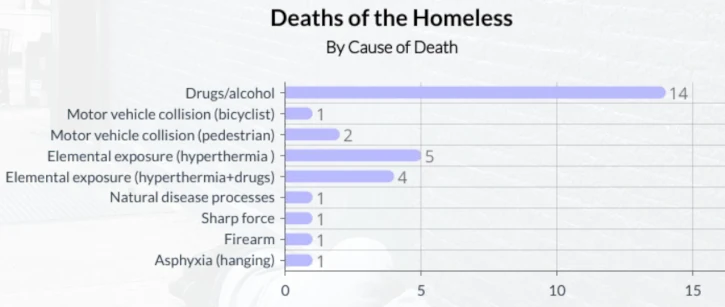
Surprising Heat Death Findings
Heat-related deaths in Pinal County totaled 35 cases in 2024, increasing from 20 in 2023. Arizona’s particularly brutal summer temperatures and extended duration of high heat contributed to this increase. The vast majority of victims were over age 71 and had cardiac comorbidities including hypertension, congestive heart failure, atrial fibrillation, and other cardiac abnormalities.
Most surprising to investigators was that 18 deaths (51%) occurred indoors rather than in outdoor desert conditions. Of the 18 indoor deaths, climate control systems were found non-functional or inadequate in 14 cases (77.7%), two systems were set to “heat” despite high outdoor temperatures, and one was turned off. The data challenges assumptions that heat deaths occur primarily outdoors, revealing hidden risks among older adults indoors.
Accreditation and Capacity Planning
As Pinal County continues its rapid population growth, the Medical Examiner’s Office expects proportional increases in death investigations across all categories. The office has submitted an application for accreditation by the National Association of Medical Examiners and is currently awaiting inspection. If successful, this could become the third fully accredited medical examiner’s office in Arizona, pending inspection results.
The annual report serves as a crucial tool for tracking trends and demonstrating the office’s impact within the death investigation system. The trends revealed will likely guide public health initiatives, law enforcement strategies, and resource allocation decisions as county officials work to address the challenges accompanying Arizona’s fastest-growing population center.
